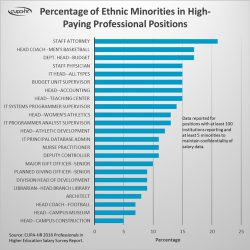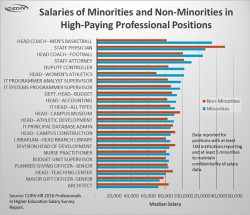PRESS RELEASE
April 11, 2016
Contact Information:
Missy Kline
Content Manager – Communications and Marketing
[email protected]
877-287-2474
Survey Shows Ethnic Minorities Are Underrepresented in High-Paying Professional-Level Positions in Higher Ed
Pay, For the Most Part, Is Equitable
According to the U.S. Census Bureau, approximately 23% of working-age adults are ethnic minorities; however, the percentage of minorities in professional positions in higher ed with median salaries of $80,000 or greater is much lower. Data from the College and University Professional Association for Human Resources (CUPA-HR) 2015-16 Professionals in Higher Education Salary Survey show that in 23 high-paying positions, the percentage of minorities ranges from 5% to 21%. However, despite this underrepresentation, pay is for the most part equitable, and in many cases minorities outearn non-minorities.


Other Findings
- The median base salary increase this academic year for those in professional-level positions for all institutions combined was 2.0%.
- Salary increases by Carnegie class ranged from 2.0% at master’s institutions to 2.4% at special focus schools. By affiliation, increases were higher at private doctoral and special focus institutions (2.4% and 2.5%) than at their public counterparts (2.0% and 2.3%).
- For seven of the 11 job categories in the survey, median increases were slightly higher (one-tenth of a percent to nearly half a percent) at private institutions than at publics. For all institutions combined, professionals in institutional affairs saw the greatest salary increase (2.5%).
- DOL’s proposed change to the salary threshold for exempt employees could have a significant impact on many professional-level positions in higher ed. Currently, all positions reported in the Professionals survey are considered exempt. However, if the proposed rule is implemented as is, 47 positions could see their status change from exempt to nonexempt.
- Coaches’ salaries – For virtually every sport reported in the survey, coaches at public institutions are paid more than coaches at private institutions. Not surprisingly, football head coaches have the highest median salary. Head coaches for men’s athletics occupy the top three spots (football, men’s ice hockey, men’s basketball). Although two women’s athletics head coaches are among the top highest-earning coaching positions (women’s basketball and women’s gymnastics), their median salaries hover around the $100,000 mark, more than one quarter lower than the third-highest men’s athletics head coach salary.
Findings from the 2015-16 Professionals in Higher Education Salary Survey reflect the salaries of 200,000 job incumbents in public and private institutions nationwide. Salaries were reported by 1,079 institutions for 334 professional-level positions.
Visit the CUPA-HR website to order results and to see more data from the 2015-16 Professionals in Higher Education Salary Survey.
About CUPA-HR
CUPA-HR is higher ed HR. We serve higher education by providing the knowledge, resources, advocacy and connections to achieve organizational and workforce excellence. Headquartered in Knoxville, Tennessee, and serving more than 20,000 HR professionals and other campus leaders at more than 1,900 member organizations around the country and abroad, the association offers learning and professional development programs, higher education salary and benefits data, extensive online resources and just-in-time regulatory and legislative information.
CUPA-HR surveys are designed by higher ed HR and research professionals for higher ed HR and research professionals.


